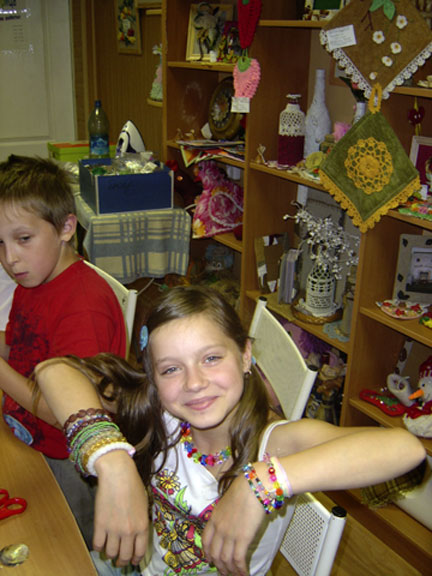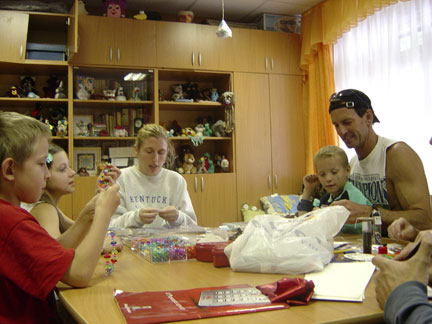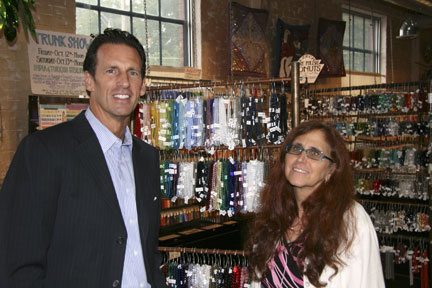
Columbus, Ohio USA
Return to Homepage www.shortnoth.com
To Russia with love
Byzantium's bead donation wins hearts of Russian orphans
September 2007
by Karen Edwards
Nastya, age 12, showing off her many bracelets, while Misha, also 12, looks on. For Mark Fazzina, epiphany arrived during an HBO airing of the World Cup soccer game. The Short North resident (he lives in Italian Village) and employment consultant was looking to travel abroad again, but he wasn’t sure where he wanted to go. He did know he didn’t want to go as a tourist. He wanted to volunteer – somewhere, doing something. Then, there it was. A commercial about an organization, MiraMed, that works to help Russian women caught in the web of human trafficking – and, oh yes, they also provide volunteers to Russian orphanages who are in need of extra hands.
Soon after the commercial aired, Fazzina was on the phone with the Seattle-based MiraMed, offering to work in a Russian orphanage as a summer volunteer. That meant he would spend his time living, eating and working in an isolated, rural part of Russia, sleeping on bunk beds, eating with the children. It may not be everyone’s idea of a dream vacation, but Fazzina says he was looking forward to it.
MiraMed had also sent him the names and e-mail contacts for others who would be volunteering this summer – two men and two women – and the five quickly began corresponding with each other.
“MiraMed doesn’t have any formal program or schedule at the orphanage,” says Fazzina. They said they’d leave the planning up to us.” He was told, however, that the children enjoy working on craft projects, like jewelry-making.
That’s when Fazzina had a second epiphany. He was aware of the Short North bead shop Byzantium and wondered if its owner might be willing to donate beads to the Russian orphans.Hand-picked beads
“I didn’t know Mark at all before he called,” says Byzantium owner, Joyce Griffiths – and it’s not as though Griffiths doesn’t receive dozens of these calls every month. When she can, she obliges by donating $50 to $100 worth of beads or gift cards to those who ask. “The community supports us, so I like to support the community,” she says. Most of her donations go to schools and churches, but she has also donated beads to students traveling to Mexican work camps and to the art therapy program at Ohio Health’s Riverside hospital, where participants make bracelets to promote cancer awareness. This was the first time, however, that she was asked to send beads to Russia.
“I was out when he called, so he left a message with one of my staff,” says Griffiths. “I called him back and asked some questions about the project.” Of course she said yes.
“She was incredible,” Fazzina says. “She asked the ages of the children and how many of each gender there would be, and then she took the time to personally select beads that would be appropriate for the group.”
Griffiths says such information-gathering and selection comes as second nature to her by now.
“I’ve had enough experience to know girls like to work with bright and pastel colors and boys prefer colors that are darker or more muted,” she says.
She also knows enough to include plenty of beads with large holes for younger children whose hand-eye coordination isn’t quite ready for beads with smaller openings. And while hand-eye coordination isn’t an issue for the older boys, Griffiths knows to throw in extra beads with large holes for them. “Boys aren’t as patient as girls when it comes to stringing beads,” she says. Girls are happy to sit for hours making exactly what they want. Boys will stay with beading for awhile, then want to move on to other things, she says. “But everyone enjoys making something. Beading is an activity for boys as well as girls.”
By the time Griffiths had assembled everything, there was a bag containing $150 worth of craft material. Inside, were beads of all shapes, sizes and colors: wooden beads, ceramic beads, horn beads, even beads designed to look like tiny soccer balls and footballs for the boys, and beads imprinted with or shaped like flowers and butterflies for the girls. There were also small charms, stringing material, clasps and a tool kit.
“It was all really nice merchandise,” says Fazzina. “I was surprised by the quality and the volume she gave me.”
Griffiths sat down with Fazzina and explained everything to him when he arrived to pick up the bag. “I even offered to show him how to string beads,” she says.
Fazzina was more than pleased with the donation. “She went well beyond what I had hoped for,” he says.
Having fun making necklaces, bracelets, and other crafts. From left to right are Misha, Nastya, Carrie (one of the other volunteers), and Mark Fazzina with Grisha, age 7. Russia’s social orphans
In Russia, the donation made it through customs without problems, and soon Fazzina, his four volunteer colleagues and a translator were packed in a van and heading to Kostroma, 320 miles north of Moscow where the orphanage, Detski Dome #1, was located.
“Many of the orphans are what are known as social orphans,” says Fazzina, explaining their parents are typically alive but because of poverty, alcoholism or incarceration, are unable to care for them.
The children at the orphanage ranged in age from 7 to 17 years. Orphans are asked to leave once they turn 18, says Fazzina. “But they don’t have any life skills yet and nowhere to go. It’s a problem,” he says.
The MiraMed Web site puts it in more startling terms: “When orphans are ‘emancipated’ at age 17 to make their way in the world, more than half are recruited to a life of crime, prostitution, 10% commit suicide, 30% are addicted to alcohol and other drugs during their first year of living independently. This data is from Russian governmental sources, which are often underreported.”
MiraMed’s summer camps hope to prevent these ominous statistics by teaching the older children life skills which can help them earn a living, such as sewing and carpentry. At the same time, the camps must keep the younger children entertained with activities like sports, theater, and arts and crafts. That’s where the volunteers come in.
“I was outside playing basketball with some of the kids when they first put the beads out,” Fazzina recalls now.
There was no formal distribution process. The colorful beads were simply spilled onto a table and the stringing material placed alongside.
“By the time I came in, there were children all over the place making jewelry,” Fazzina says. “They were definitely excited by all the beads.”
The orphans continued to fashion jewelry the entire length of Fazzina’s three-and-a-half week stay, he says – and there was still plenty of material remaining for the older kids when they returned from camp.
“I think everyone made something,” says Fazzina.
Mark Fazzina with Joyce Griffiths, owner of Byzantium. Photo/Darren Carlson From Russia with love
When Fazzina arrived back home in the United States, he didn’t come home empty-handed. He brought with him a necklace and hemp bracelet made for him by two of the children from the orphanage – two who happened to steal his heart.
“There was a boy named Grisha, he was 7, and he had some developmental problems,” says Fazzina. “The whole time I was there, he didn’t have a single family member visit him.”
As a result, Fazzina says he began to spend more time with him, as well as with a shy 12-year old girl, Anastasia or “Nastya,” who latched on to Fazzina from the start. “She had a sister who would come to visit her, but I never saw anyone else,” Fazzina says.
In recent years, the Russian government has made it difficult for people outside the country to adopt Russian children. If that weren’t the case, Fazzina says he’d consider adopting both Grisha and Nastya. He may still look into it, he says, but at the very least, he’ll see if there is some way he can sponsor the children while they’re still under state care – and he vows he’ll stay in touch with both.
“They may move Grisha to a place that can provide him some special-needs help,” Fazzina says.
That’s why he says he’ll remain in touch. He wants to know what happens to them now that he’s gone.
“I want to go back next year,” he says. And, of course, he’ll want to look up Grisha if the child has been moved to another facility.
Will he bring more beads with him on his next trip? Possibly.
If he decides that’s something he would like to do, says Joyce Griffiths, she’ll be at Byzantium – happy to take his call.Visit www.miramed.org
© 2007 Short North Gazette, Columbus, Ohio. All rights reserved.


